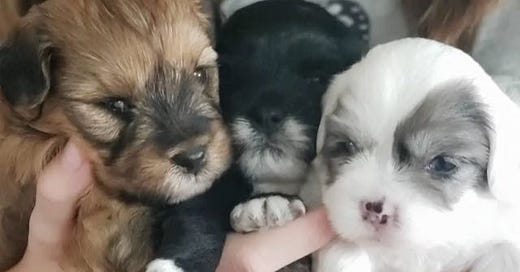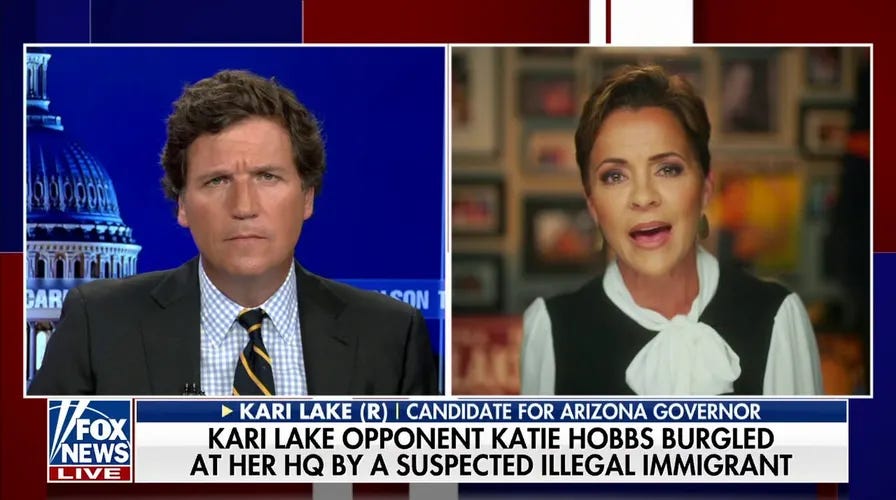Wednesday Walk: Puppy Talk
Welcome to the Quarantine Creatives newsletter, a companion to my podcast of the same name, which explores creativity, art, and big ideas as we continue to live through this pandemic.
Every Wednesday, I share random thoughts and tidbits with links to let you do some exploring. I call these Wednesday Walks, as it’s the type of conversation we might have walking down a path in the woods- the topics are free flowing, sometimes related, sometimes not.
If you like what you’re reading, please consider a free subscription to have this newsletter delivered to your inbox:
Happy Wednesday! Did you stay up a little too late watching election results come in? I went to bed early, but am feeling better waking up this morning!
Anchor Candidates
It seems like it may be a while before some key races from yesterday are fully called. The race for governor of Arizona will likely be one of them, although as of this writing, Democrat Katie Hobbs has a strong lead. Kari Lake is the Republican candidate in that race, and Tim Murphy published a fascinating profile of her on Mother Jones yesterday.


Lake has run her candidacy like Donald Trump’s re-election campaign in 2020: largely election lies and fear mongering. It seems that formula may not have paid off in this case, but again, it’s still early. In Murphy’s piece, he looks at Lake’s history as a local news anchor at Fox 10 in Phoenix and how skills in local news translate to politics:
“‘News anchors in large part are hired because of their ability to connect with people,’ one former local news anchor who ran for office told me. ‘They focus-group us when they bring you into big cities for a Monday through Friday anchor job. Your ability to connect and be dynamic on camera is literally the qualification. And trustworthiness. Three things that are critically important when it comes to a political campaign.’”
Many Republican candidates this cycle ran explicitly on a fear of crime, rather than focus on more tangible issues like inflation and the economy. This is right out of the local news playbook:
“‘A former local TV news personality is perfect for running a campaign based on fear and especially fear of crime because that’s what they do pretty much every day at their previous job,’ says Barry Glassner, a sociologist and author of The Culture of Fear: Why Americans Are Afraid of the Wrong Things. ‘It’s sort of a natural transition.’”
Murphy also cites an article from earlier this year from Layla Jones for the Philadelphia Inquirer which looked at two local stations in Philadelphia and how they covered crime. Murphy’s summary:
“But the stations didn’t cover all crime equally. They disproportionately covered crimes committed by Black people, for an audience that was disproportionately white, and which, increasingly, did not live in the neighborhoods on which Eyewitness and Action News focused their crime coverage. This was a different kind of service journalism—validation for white flight.”
Murphy tracks the number of candidates running from both parties this cycle with a background in local news, including races in Illinois, Florida, Iowa, and New Mexico.
What’s fascinating to me is the value of a local news personality in certain markets, and how quickly that celebrity vanishes on a national stage. I had no knowledge of Kari Lake prior to her running, although I would often see her on TV appearances (clipped to Twitter) with soft lighting and shallow focus, thinking “who is this lady?” Knowing her background as a local news anchor (and her husband’s background as a local news photographer), it makes a lot more sense.
Being a local celebrity matters in local races, but it becomes harder to quantify statewide or on a national scale. Celebrities have often made the transition to politics, but it’s usually bigger stars than local news personalities that reach the higher offices (Reagan, Schwarzenegger, Franken, Trump).
Whether or not her TV training gets Lake over the finish line in Arizona, the notion of local news as a training ground for future politicians is an interesting idea and worth some examination and inspection, especially as groups like Sinclair consolidate ownership of local media outlets (watch John Oliver discuss this back in 2017 on his HBO show):
Good Dog
For the sake of a timeline cleanse, I wanted to share some news with you all. My family will be adopting a puppy next month!
We have been considering adding a dog to our family for a few years now. We were on a breeder’s waiting list for a while, but it never quite worked out. We nearly brought home a dog from Lancaster, PA this summer when the driver giving us a buggy tour mentioned that his parents had puppies for sale (I wrote about that tour here), until we realized that a puppy isn’t the best impulse buy in the middle of an RV vacation.
We were finally moved to take the plunge when my cousin’s dog had puppies that needed a home. We will likely be adopting the brown dog on the left. It’s a Lhasapoo, which will be somewhere between 10-20 pounds when fully grown.
We’ve been doing a lot of work to prepare for the new dog, and one of the most helpful resources has been discovering Tamar Gellar, a dog trainer whose approach is called “The Loved Dog” method.
We heard two fascinating podcasts with Tamar, one with Dr. Steven Gundry (who I interviewed on my podcast) and one with Dhru Purohit. The episode with Dhru is more than two hours long, but is worth a listen.
Tamar uses a psychology based approach to training dogs, essentially looking at them like little humans. Understanding how the dog is communicating and what it needs is the key to having a strong relationship with your pooch. However, much of her advise also translates to how we deal with other humans too, both kids and adults.
If you’re looking for a good podcast for an upcoming drive or plane ride, I highly recommend either interview and also checking out Tamar’s books, including The Loved Dog.
#NoNewClothes- Week 3
I am now three weeks into the challenge to not buy any new clothes for a year, inspired by my conversation with Amory Sivertson a few weeks ago.
On Sunday, I mentioned visiting a textile mill in New Hampshire and seeing a demonstration of how thread is turned into socks. I wanted to back up one step further in the production line and share a post from Ryland Engelhart on Instagram about cotton production (click below to expand it and play the video):
Ryland is co-founder of Kiss the Ground, a group that helps advocate for regenerative agriculture and put out an amazing documentary about the subject, which is streaming on Netflix.
According to Ryland’s post:
“Cotton only covers 2.5% of the world’s cultivated land, yet it accounts for 24% of the world’s insecticide market and 11% of sale of global pesticides; or $2.6 billion worth of pesticides making it the most pesticide-intensive crop grown on the planet.”
Much of the focus on reducing agricultural pollution has rightly centered on food crops and large-scale meat operations, but clearly, there is just as big of an issue to be addressed with our fabrics and textiles.
For now, I wanted to just plant that seed, and I’m sure we’ll be continuing to explore where our clothes come from at greater length over the coming weeks.
Other Wednesday Walks
#NoNewClothes, Walter White's Ride, and AI Imagery
If you’d like to catch up on past episodes of the Quarantine Creatives podcast, they can be found on Apple Podcasts, Spotify, or wherever you listen.
Please consider sharing this with a friend that you think might enjoy it, or better yet, share it on social media so you can tell hundreds of friends!
If you’ve missed past issues of this newsletter, they are available to read here.
Stay Safe!
Heath








